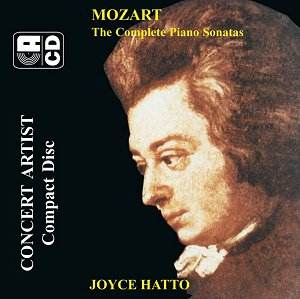While reviewing
Volume 1 in this cycle, I remarked
that Joyce Hatto "doesn’t actually
‘do’ much with the music, she just plays
it with a simplicity and a serenity
which made me think of Clara Haskil".
Since then I have learnt from Mr. Barrington-Coupe
of Concert Artist that Hatto did in
fact study most of the sonatas with
Clara Haskil. I suppose I could have
found this out by looking up Hatto’s
CV but I am rather glad to have arrived
at that conclusion with my own ears!
Mr. Barrington-Coupe also quotes some
of Haskil’s dicta to Hatto which (with
his permission) I repeat:
"We must rub away
all the ideas, gloss and lipstick
added to the text by successions of
editors, flashy pianists (some
named) and get back to the original
intentions of the composer who
knew better than all of them".
"Keep it simple
and let the music speak for itself."
"You, the pianist,
are not important because it is
the composer we wish to hear."
"Mozart is important, Haskil
is not, Hatto is not (some other names
were mentioned but these, out
of respect, are not repeated), the music
speaks through you but it is Mozart's
voice. You are a 'Medium' and if you
are faithful to the music then Mozart
will always be with you."
I hope my reaction
is not being coloured by what I now
know, but this final disc in the series
seems to me the finest of all and a
perfect demonstration of the ideals
which Hatto learnt from Haskil. The
so-called "easy" C major sonata
is unfolded with a simplicity and a
naturalness which makes it sound the
easiest thing in the world but which
in reality has taken a lifetime to achieve.
Just one illustration; after the second
subject of the first movement, with
its "buzzing" accompaniment,
Hatto permits herself a touch of pedal
for the new arpeggio-based theme. The
music suddenly becomes illuminated with
human warmth. The precise dosing of
that touch of pedal could have been
no easy matter to get exactly right.
The same simplicity
and naturalness is maintained in the
much grander B flat major sonata, possibly
Mozart’s finest sonata for piano. The
D major, rather like Mozart’s last concerto
for piano and orchestra, also in D,
is sometimes considered a relatively
superficial work – D major was always
a "festive" key for Mozart.
While lacking nothing in brilliance,
Hatto finds the music behind the notes.
The disc concludes with the F major
sonata, presumably left as a "postscript"
because of its composite nature – or
did Hatto feel that its gentle concluding
rondo would make a suitable farewell
for the cycle? In some earlier discs
I had slight reservations over Hatto’s
way of playing some of Mozart’s Allegretto
finales as gentle farewells rather than
brilliant conclusions, but this particular
movement is marked Andante in my Peters
edition (though it is apparently marked
Allegretto in the edition Hatto is using)
and the tempo sounds perfect to me.
With regard to editions,
Joyce Hatto has been kind enough to
inform me that while she was studying
with Zbigniew Drzewiecki in Warsaw he
gave her photocopies of some early printed
editions in which Mozart had written
variants for the daughter of Christian
Cannabich. A reminder that for a composer
his music is always "work in progress"
even after publication. These annotated
copies were apparently acquired by Artaria
but the variants were not incorporated
in subsequent editions. I wonder what
happened to these copies, especially
in view of the fact that Hatto’s own
photocopies were lent to a famous pianist
who never returned them. Unfortunately
the so-called Urtext editions rarely
provide much evidence as to how they
reached their conclusions – strange
really when one thinks that even the
humblest scholastic edition of a play
by Shakespeare usually has pages and
pages of "apparatus criticus",
so it is difficult to know if these
variants have been seen by the various
editors.
I have made comparisons
all along with the RCA set recorded
by Alicia de Larrocha, since I gave
this "record of the month"
status when I reviewed it. Anyone who
took my advice and bought that set can
be well content, but I would now very
marginally prefer Hatto. Basically,
the differences are that de Larrocha
sees the sonatas as a historical sequence
beginning with rococo works leaning
on Johann Christian Bach and looking
back to Scarlatti, then gradually acquiring
breadth and maturity as the cycle proceeds,
while Hatto finds the mature Mozartian
voice even in the earliest works. Both
views are obviously valid. By the time
of the late works in Hatto’s 5th
volume the difference between the two
has become minimal – de Larrocha takes
one second (!) longer over the first
movement of the B flat sonata, her slow
movements are sometimes broader still
than Hatto’s and her finales not noticeably
faster. It is interesting that, while
both artists are concerned with projecting
Mozart rather than themselves, the artist’s
personality does remain nevertheless
– de Larrocha the more impetuous, Hatto
gentler – and it is all the more fascinating
to find this when, as often in these
four works, their tempi and basic approach
seem, on the face of it, to be almost
identical. For this reason I would strongly
recommend those who have the de Larrocha
set to supplement it with at least Hatto’s
last volume – they will be rewarded
by many hours of fascinating comparisons.
For the record, neither
set includes the composite K.547a sonata;
de Larrocha also provides the Rondos
and the D minor Fantasia but since the
Hatto cycle is actually the first five
volumes of the complete works for piano
I presume all these and much else will
be released in due course.
Christopher Howell
Reviews Mozart
Volume
1 Volume
2 Volume
3 Volume
4 Volume
5
Complete
listing of Concert Artist recordings


